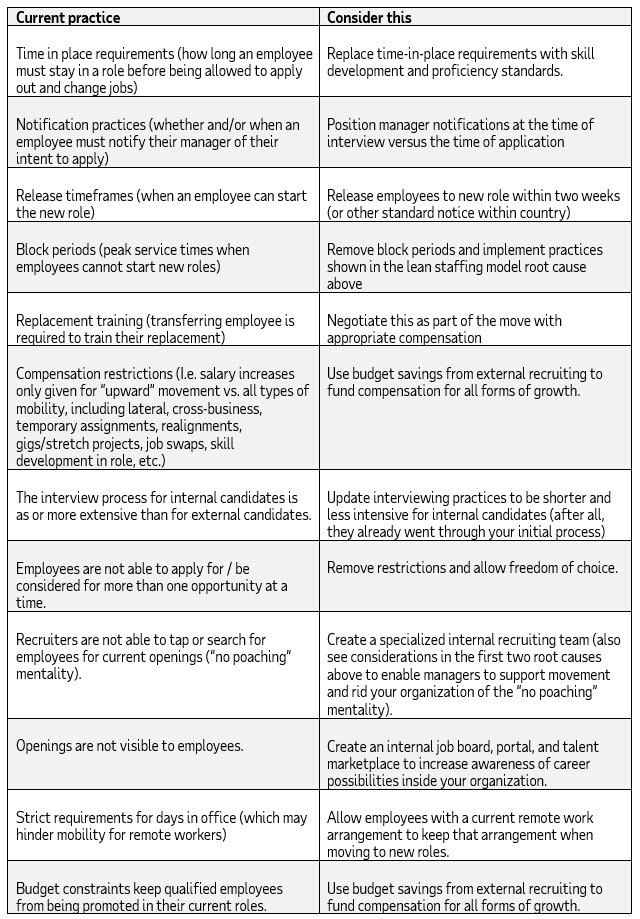Accelerate Your Career Mobility Initiatives by Breaking Down Systemic Barriers

Now that we can all agree that the traditional career ladder is NOT the only way to grow, many companies are investing time and effort into initiatives to increase internal mobility for their employees. This can be followed by the realization that long-standing organizational practices are hindering the various forms of internal mobility.
Accelerating your career mobility initiatives requires identifying root issues (aka systemic barriers) that might be stunting your employees' growth and making a committed effort to break them down.
Talent hoarding, who's really at fault?
Talent hoarding has been discussed for decades, with the manager typically cast as the villain. And let's face it: it can be easy to blame the managers in your organization when employees cite their reason for leaving as "lack of career opportunities."
But when digging deeper, we will likely root out foundational systemic issues – such as staffing models, compensation practices, and employee transfer policies – that challenge managers to openly support their staff's growth outside of the team.
Root 1: Lean staffing models
Increasingly high business expenses have led companies to consistently search for ways to do more with less. With labor costs accounting for the most significant of these expenses, it's no surprise that most successful large companies run with very lean staffing models – employing as few workers as possible to get the job done and subscribing to the "do more with less" mentality. Complex and lengthy approval processes for expenditures (such as hiring more workers) will often accompany these models.
Let's look at a manager with a team of 10. Suppose two team members are actively considering other roles within the company, and the team is already stretched with a heavy workload. The manager must consider how the same amount of work will get done if they support the transfer of the two team members.
If the two transfer, the remaining team members and the manager will now bear the burden of achieving quality, productivity, and any other assigned metrics as a smaller team until replacements can be hired, trained, and brought up to the same productivity levels as the two who moved on.
If workload is listed in your exit surveys as a primary reason for employee turnover, you can see what a conundrum this situation creates, and how the manager is put in an almost impossible position.
To break down this barrier, consider these:
- At the ready bench for feeder/entry level roles (including temporary or contract workers)
- Auto-approval of replacement head count upon awareness of employee transfer interest (sourcing, interviewing, and possibly training can run concurrently with the employee transfer process)
- Short-term assignment (gig-work) offerings to build employee skills and offset staffing shortages
Root 2: Inflexible performance expectations and plans
Pay for performance is a common compensation strategy where employees' earnings are directly tied to how well they perform their jobs. The logic is that employees who perform better should be paid more, which will lead to better overall business outcomes. Performance expectations are most often set at the beginning of the year, with compensation (salary, bonus, equity, other perks, etc.) determined based on their achievement.
In reference to the prior example: Suppose the two team members who move to another department are among the top performers. In that case, the leader faces a second compounded conundrum – the impact on his/her own performance metrics and, therefore, rewards.
If the way an organization compensates its leaders does NOT include a reward for growing and exporting talent, it is essentially requiring them to sacrifice their own pay for their team members' career mobility.
To break down this barrier, consider these:
- Flexible performance expectations that account for the make-up of the team (if a top performer is replaced with an inexperienced worker, the leader's target is updated)
- Shorter-term performance targets and rewards (i.e. monthly or quarterly vs. annually)
- Modernized leader rewards practices that prioritize employee development and growth (including job moves)
Root 3: Employee transfer policies
The first two root issues make it difficult for managers to support the growth and mobility of their team members. Organizational barriers also make mobility difficult for the employees themselves.
Many organizations have policies regarding employee transfers. Below, the left column of the table shows the possible components of these policies, and the right column shows potential solutions to consider.

For each component above, ask yourself (and your employees) – does this practice make it EASIER or HARDER for our employees to grow? A thorough review of these practices may have you realizing that your organizational practices are instead motivating your folks to leave.
Changing these practices one by one won't solve the whole; instead, this is a movement that will take time and effort to effect real change. The vision is to get to the state where your employees are growing and moving so regularly that stretch assignments and other types of experiential learning are plentiful, you're in a rhythm of planning for backfills and bench readiness, and leaders and employees are winning in the growth mindset.
The bottom line is that evolving our talent practices is essential for our organizations to achieve optimal outcomes and success!
Now more than ever, if your employees can't find the right fit where they are — whether that's with compensation, benefits, culture, engagement or career path — they are willing and able to go somewhere else. Businesses must evolve to survive and thrive. The question is how?



